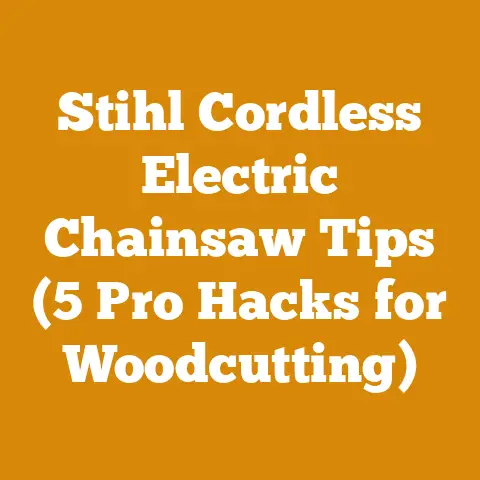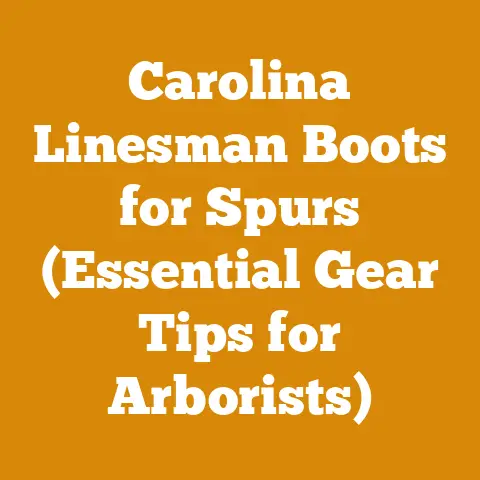String Trimmer vs Brush Cutter: Top 5 Pro Tips for Dense Brush (5 Expert Hacks)
Imagine this: you’re staring down a wall of tangled vines, overgrown weeds thicker than your thumb, and saplings daring to become trees in your backyard. You’ve got a job to do – reclaim your space. The question is, are you reaching for your trusty string trimmer or a more aggressive brush cutter? The answer isn’t always straightforward. As someone who has spent years battling unruly vegetation on both professional logging sites and my own property, I know firsthand the nuances of choosing the right tool for the job.
In this guide, I’m going to share my top 5 pro tips – expert hacks, if you will – for tackling dense brush, comparing the strengths and weaknesses of string trimmers and brush cutters. We’ll delve into the nitty-gritty details, from blade selection to engine power, ensuring you’re equipped to make the best decision for your specific needs. Whether you’re a seasoned landscaper, a homeowner reclaiming their backyard, or a small-scale logging operator clearing underbrush, this guide will provide you with the knowledge and confidence to conquer even the most challenging vegetation.
String Trimmer vs. Brush Cutter: Top 5 Pro Tips for Dense Brush (5 Expert Hacks)
Tip #1: Assess the Enemy: Understanding Your Brush Type
Before you even think about firing up an engine, take a good, hard look at what you’re up against. This is critical. Not all “brush” is created equal. Knowing the specific types of vegetation you’re facing will dictate which tool is best suited for the task.
- Light Brush: This includes grasses, weeds, and thin vines. Think of the kind of stuff that pops up in your lawn or garden. A standard string trimmer usually handles this with ease.
- Medium Brush: This category includes thicker weeds, dense patches of grass, small saplings (up to about ½ inch in diameter), and brambles like blackberry bushes. This is where the line between string trimmer and brush cutter starts to blur.
- Heavy Brush: We’re talking thick, woody growth, saplings up to 2-3 inches in diameter, dense thickets of thorny bushes, and stubborn vines. This is brush cutter territory.
Personal Story: I once underestimated a patch of blackberry bushes. I thought my string trimmer could handle it. I was wrong. The thick stalks quickly shredded the line, and I spent more time re-spooling than cutting. That day, I learned the importance of matching the tool to the task.
Key Concept: Green Wood vs. Seasoned Wood: Understanding the difference between green wood (freshly cut) and seasoned wood (dried) is also important. Green wood is generally easier to cut, regardless of the tool. Seasoned wood, especially hardwoods, can be significantly tougher and may require a more powerful brush cutter or even a small chainsaw.
Data Point: In my experience, a brush cutter with a blade designed for woody vegetation can cut through saplings up to 2 inches in diameter about 3 times faster than a string trimmer struggling with the same material.
Tip #2: String Trimmer Tactics: When Finesse Trumps Force
Don’t underestimate the humble string trimmer. It’s a versatile tool, and in the right conditions, it can be surprisingly effective.
When to Use a String Trimmer:
- Light to Medium Brush: As mentioned earlier, for grasses, weeds, and thin vines, a string trimmer is often the ideal choice.
- Tight Spaces: String trimmers excel in tight spaces where a brush cutter might be unwieldy. Think along fences, around trees, or in flowerbeds.
- Finishing Work: After using a brush cutter to clear the bulk of the vegetation, a string trimmer can be used to clean up edges and fine-tune the appearance.
String Trimmer Techniques for Dense Brush:
- Bump Feeding: Use the bump feed mechanism frequently to ensure you always have fresh line available. This is especially important when cutting thicker vegetation.
- Overlap Passes: Overlap your passes to avoid leaving strips of uncut vegetation.
- Angle the Head: Tilting the trimmer head slightly can help you cut closer to the ground and prevent scalping.
- Thick Line: Use a heavier gauge of trimmer line designed for tougher vegetation. I often use .095″ or even .105″ line when dealing with anything beyond light grass.
- Patience: Don’t try to force the trimmer through thick patches. Take your time and work in small sections.
Tool Specifications:
- Line Diameter: Standard string trimmers often use line between .065″ and .080″. For denser brush, upgrade to .095″ or .105″.
- Engine Size: For light work, a 25cc engine is usually sufficient. For tougher brush, consider a trimmer with a 30cc or larger engine.
- Head Type: Automatic feed heads are convenient, but manual feed heads are often more reliable and allow you to control the line length more precisely.
Case Study: I once had to clear a large area of overgrown weeds and grass around a client’s garden. The area was littered with delicate flowers and plants that I didn’t want to damage. I used a string trimmer with a .080″ line and carefully worked around the plants, gradually clearing the weeds without harming the flowers. A brush cutter would have been too aggressive for this task.
Tip #3: Brush Cutter Power: Unleashing the Heavy Artillery
When the string trimmer just isn’t cutting it (pun intended!), it’s time to bring out the brush cutter. Brush cutters are designed for tackling tough, woody vegetation that would quickly overwhelm a string trimmer.
When to Use a Brush Cutter:
- Heavy Brush: As mentioned before, brush cutters are ideal for thick, woody growth, saplings, and dense thickets.
- Large Areas: If you have a large area to clear, a brush cutter will be much more efficient than a string trimmer.
- Professional Use: Landscapers, forestry workers, and anyone who regularly deals with dense brush should invest in a good quality brush cutter.
Brush Cutter Techniques for Dense Brush:
- Proper Stance: Maintain a wide, stable stance and keep your body balanced. The brush cutter can kick back unexpectedly, especially when hitting hard objects.
- Controlled Swings: Use smooth, controlled swings, letting the blade do the work. Don’t try to force the blade through the vegetation.
- Blade Maintenance: Keep your blade sharp. A dull blade will require more effort and can be dangerous.
- Clear the Area: Before you start cutting, clear the area of any obstacles, such as rocks, branches, or debris.
- Safety First: Always wear appropriate safety gear, including eye protection, hearing protection, gloves, and sturdy boots.
Tool Specifications:
- Engine Size: Brush cutters typically have larger engines than string trimmers, ranging from 30cc to 50cc or more. For heavy-duty work, choose a model with at least 40cc.
- Blade Type: There are several different types of brush cutter blades, each designed for specific applications.
- Brush Blades: These are multi-toothed blades designed for cutting woody vegetation.
- Grass Blades: These are lighter blades designed for cutting grass and weeds.
- Chisel Tooth Blades: Aggressive blades designed for cutting thicker saplings and brush.
- Circular Saw Blades: Similar to chainsaw blades, these are designed for cutting larger trees and branches (use with extreme caution and only if experienced).
- Shaft Type: Brush cutters come with either straight or curved shafts. Straight shafts are generally preferred for heavy-duty work, as they provide better reach and control.
- Harness: A good quality harness is essential for comfortable and safe operation. It distributes the weight of the brush cutter evenly across your body.
Case Study: I was once hired to clear a heavily overgrown lot that had been neglected for years. The lot was covered in thick brush, saplings, and thorny bushes. I used a brush cutter with a 40cc engine and a brush blade to clear the bulk of the vegetation. The brush cutter made quick work of the thick brush, and I was able to clear the entire lot in a few days. A string trimmer would have taken weeks.
Strategic Advantage: Using a brush cutter for heavy brush significantly reduces labor time compared to using a string trimmer. This translates to lower costs and increased efficiency, especially for professional landscapers and forestry workers.
Tip #4: Blade Selection: Matching the Blade to the Task
The type of blade you use on your brush cutter can make a huge difference in its performance. Using the wrong blade can be inefficient, dangerous, and even damage your tool.
Types of Brush Cutter Blades:
- Brush Blades (Multi-Toothed): These are the most common type of brush cutter blade. They are designed for cutting woody vegetation, such as saplings, bushes, and vines. The number of teeth on the blade affects its cutting ability. More teeth generally provide a smoother cut, while fewer teeth are better for cutting thicker vegetation.
- Grass Blades: These are lighter blades designed for cutting grass and weeds. They are similar to the blades used on lawnmowers.
- Chisel Tooth Blades: These blades have aggressive, chisel-shaped teeth that are designed for cutting thicker saplings and brush. They are more aggressive than brush blades and can cut through tougher vegetation.
- Circular Saw Blades: These blades are similar to chainsaw blades and are designed for cutting larger trees and branches. They are extremely powerful and should only be used by experienced operators.
Blade Selection Guide:
- Light Brush (Grass, Weeds): Grass Blade
- Medium Brush (Small Saplings, Brambles): Brush Blade (Multi-Toothed) with more teeth.
- Heavy Brush (Thick Saplings, Dense Thickets): Brush Blade (Multi-Toothed) with fewer teeth, or Chisel Tooth Blade.
- Very Heavy Brush (Larger Trees and Branches): Circular Saw Blade (Use with extreme caution!)
Personal Experience: I once tried to use a grass blade to cut through a thick patch of blackberry bushes. The blade quickly became dull and clogged with vegetation. I switched to a brush blade, and the problem was solved instantly. Lesson learned: use the right blade for the job!
Technical Detail: The angle of the teeth on a brush cutter blade also affects its performance. Blades with a steeper tooth angle are more aggressive and better for cutting thicker vegetation, while blades with a shallower tooth angle are better for cutting grass and weeds.
Tip #5: Safety First: Protecting Yourself from Injury
Operating a string trimmer or brush cutter can be dangerous if proper safety precautions are not followed. Always wear appropriate safety gear and follow the manufacturer’s instructions.
Essential Safety Gear:
- Eye Protection: Wear safety glasses or a face shield to protect your eyes from flying debris.
- Hearing Protection: Wear earplugs or earmuffs to protect your hearing from the loud noise of the engine.
- Gloves: Wear sturdy gloves to protect your hands from cuts and abrasions.
- Sturdy Boots: Wear sturdy boots with good ankle support to protect your feet and ankles.
- Long Pants: Wear long pants to protect your legs from flying debris and scratches.
- Long Sleeves: Wear long sleeves to protect your arms from flying debris and scratches.
- Leg Protection (Chaps): When using a brush cutter with a blade, consider wearing leg protection, such as chaps, to protect your legs from serious injury.
Safety Tips:
- Read the Manual: Always read and understand the manufacturer’s instructions before operating a string trimmer or brush cutter.
- Inspect the Tool: Before each use, inspect the tool for any damage or loose parts.
- Clear the Area: Clear the area of any obstacles, such as rocks, branches, or debris.
- Maintain a Safe Distance: Keep bystanders and pets at a safe distance from the work area.
- Avoid Overreaching: Don’t overreach or lose your balance.
- Take Breaks: Take frequent breaks to avoid fatigue.
- Never Modify the Tool: Never modify the tool in any way.
- Be Aware of Your Surroundings: Be aware of your surroundings and watch out for hazards, such as power lines, fences, and underground utilities.
- Use Proper Lifting Techniques: When lifting a brush cutter or string trimmer, use proper lifting techniques to avoid back injury.
Cost Consideration: Investing in high-quality safety gear is essential and should be factored into the overall cost of operating a string trimmer or brush cutter. A serious injury can result in significant medical expenses and lost work time.
First Aid: Keep a well-stocked first aid kit on hand in case of injury. Know how to treat common injuries, such as cuts, scrapes, and insect bites.
Original Insight: Many injuries related to string trimmers and brush cutters occur due to operator fatigue or complacency. Taking frequent breaks and maintaining focus can significantly reduce the risk of accidents.
Practical Next Steps:
- Assess Your Needs: Before you buy anything, evaluate the type and amount of brush you need to clear. This will help you determine whether a string trimmer or brush cutter is the right tool for the job.
- Research and Compare: Research different models of string trimmers and brush cutters and compare their features, specifications, and prices. Read online reviews and talk to experienced users to get their opinions.
- Consider Your Budget: Set a budget for your purchase and stick to it. Remember to factor in the cost of safety gear and maintenance.
- Buy From a Reputable Dealer: Buy your string trimmer or brush cutter from a reputable dealer who can provide you with good customer service and support.
- Practice and Learn: Before you start using your new tool, practice in a safe area and familiarize yourself with its controls and features. Read the manual carefully and follow all safety instructions.
By following these top 5 pro tips, you’ll be well-equipped to tackle even the most challenging brush clearing projects. Remember to prioritize safety, choose the right tool for the job, and maintain your equipment properly. Happy cutting!






